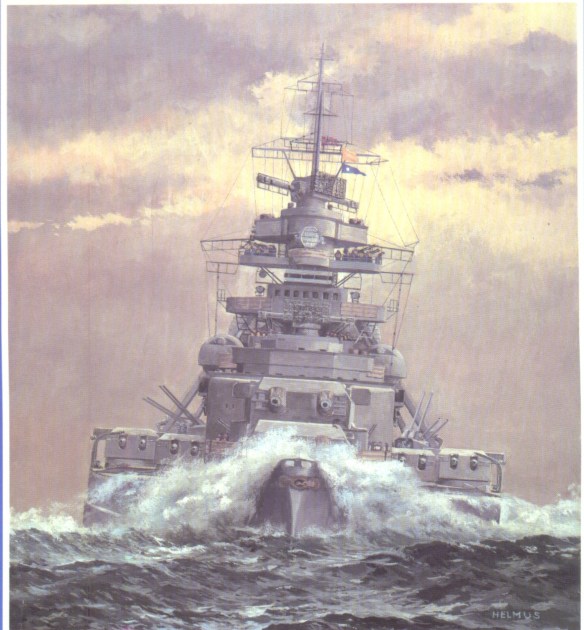Weapons and Fire Control Systems
The designers of the Bismarck class adhered to the tried and tested main armament arrangement of two twin turrets forward and aft, the rearmost of each superfiring. The reason for this was the better field of fire and more effective sequence of salvos. The smaller calibres—the 15cm secondary artillery and the 10.5cm flak—followed the previous layout.
The concept of the 15cm gun was its role as a classic anti-destroyer weapon. It fired a theoretical eight, but in practice only six, rounds per barrel per minute, and was in no respects of any value as an anti-aircraft gun, having too slow a rate of fire and turret rotation speed and an inadequate angle of elevation. Together with the main armament, it was used on Tirpitz in an anti-aircraft role as it could put up a long-range barrage of time-fused shells to confront approaching bomber formations with a curtain of shrapnel.
German naval flak was inadequate, and lacked a gun which was capable of engaging both a fast bomber at high altitude and long distance and also a torpedo bomber closing in just above the wave tops. The planners had failed to grasp the concept of the multi-purpose flak gun. There would certainly have been room for them, but it was left to other navies to address the problem and to come up with workable solutions towards the end of the war. Of course, Germany already had an excellent flak gun, the 12.7cm Flak L/45 Model 34, which had a range, at 30 degrees’ elevation, of 10,497.3m, a shell weight of 23.45kg and a muzzle velocity of 829.97m/sec and which had given outstanding results against enemy bombers over the Reich.
The VDI-Memorandum (which had had handwritten comments added in April 1957 by former ministerial adviser Dipl-Ing Ludwig Cordes, from December 1942 Chief of the Official Group for Artillery Construction at Naval Command, a personality familiar with the whole subject inside and out) drew special attention to fire direction centres with the following notable conclusion:
There was no technical expert at Naval Command (OKM) charged with responsibility for this particular interest. Rulings were ultimately within the jurisdiction of a military centre, which led to frequent erroneous decisions.’
Flak
There were two different models. The 10.5cm model C33 guns of Bismarck were fitted in twin mountings, C31 forward and C37 aft. The guns differed principally in the coordination system for their target data. In themselves both weapons were flawless, but unfortunately when the C37 had been shipped, the necessity to install the fire direction equipment individual to each model of gun had been overlooked, with the result that, when the fire direction instructions were transmitted, Flak C33 fired at the target and Flak C37 at a point beyond it. The error here clearly lay with Kriegsmarine planning, which resulted in the linking of an incompatible battery to the control centre.
Flak Direction Centres
Until the end of the war, German heavy units were equipped with grossly inferior flak direction centres based on the Cardan ring system with a large revolving base. At a massive 40 tons, their weight tended to affect the ship’s stability. In battle, many defects came to light, for the Cardan ring system was very sensitive to underwater hits: even the lightest hits could cause a break in the ring, resulting in a total system breakdown.
As early as 1932 engineers had set out proposals for an improved and more suitable development which had a smaller and triaxial rotating base. Despite repeated reminders, it was not until 1942 that the new device was first commissioned, and the experimental prototype was eventually ready by the end of the war though never fitted aboard ship. Complementing a far superior handling capability and better armour protection, the new device had a weight of only 6 tons.
In 1933 proposals had been put forward for automatic fire direction mountings for 3.7cm and 2cm guns. This demonstrates how far-sighted the German weapons engineering industry was, but in this case nothing came of the proposals.
Radar Equipment
At the outbreak of war in 1939 Germany had two workable radar systems, Freya (2.4cm waveband) and Würzburg (50cm waveband). At the time, the Third Reich led the world in this field. This would change. In the autumn of that year the British built a 12m system and then concentrated their efforts on the centimetre wavebands. In 1943, they introduced the 9cm device known to the Germans as ‘Rotterdam’.
In Germany the industry was fragmented, and instead of drawing on the experience of well-established firms, new companies were set up and the Luftwaffe commandeered all new developments. In 1942–43 it was decided that no new developments in radars of wavebands less than 20cm were possible, and all research into that area was abandoned. Only when a ‘Rotterdam’ set fell into German hands was work resumed. None of the equipment built worked satisfactorily in service. Germany had ‘missed the bus’.
These few concluding remarks may be sufficient to permit a more critical assessment of German warship construction of the period than is normally the case. At their completion, the two Bismarck class units were the culmination of capital ship building, but they were already obsolescent. They were powerful and sturdy fighting ships, but not unsinkable. In their final form they were, asthetically, the crowning glory of German warship construction.
The destruction by Bismarck of the world’s largest capital ship of the time, the battlecruiser Hood, is an impressive testimonial to German naval gunnery. But in respect of this success, it must be remembered that it was achieved against a warship which had been laid down in the Great War twenty-five years previously—certainly modernised but unchanged in her basic structure.
